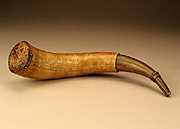| Maker(s): | Lounsbury, Samuel (attributed)
| | Culture: | American (1725-1757)
| | Title: | powder horn: Israel Putnam
| | Date Made: | November 10, 1756
| | Type: | Armament
| | Materials: | horn, wood: pine, base metal: brass; red pigment, black paint
| | Place Made: | United States; New York; Fort William Henry
| | Measurements: | overall: 5 in x 6 1/2 in x 15 in; 12.7 cm x 16.5 cm x 38.1 cm
| | Accession Number: | HD 2005.20.9.1
| | Credit Line: | Historic Deerfield, The William H. Guthman Collection of American Engraved Powder Horns
| | Museum Collection: | Historic Deerfield
|
|

|
Description:
Powder horn inscribed: “When bows and weighty Spears were us’d in Fight / Twere nervous Limbs Declr’d a man of might / But now Gun powder Scorns Such Strength to own / And Heros not by Limbs but Souls are shown W A R / Capt Israel putnam’s Horn made at / Fort wm, Henry Novr, the 10th. AD: 1756 / a plan of the Stations / From albony to / Lake George / The River, the Road” attributed to John Bush or Samuel Loundsbury. The Putnam horn is characterized by the four-line rhyme, baroque floral design, volute border at the throat, and deeply carved dark zigzag accent of the illuminated lettering of the word “WAR.” These motifs identify the work of John Bush, Samuel Lounsbury, and Nathaniel Selkrig, the most prolific Lake George horn carvers. Of special note is the “plan of the stations from albony to Lake George,” which includes diagrams of Fort William Henry (near the plug) and Fort Edward, and notes the location of smaller blockhouses along “The Road” between the two. A New England legend, Israel Putnam (1718-1790) of Pomfret, Connecticut, was a leader of a company in Rogers’ Rangers, and promoted to the rank of Major in 1758 before capture and imprisonment in Canada. Made a Lieutenant Colonel during the 1759 campaign, Putnam commanded a company during the 1762 Havana Expedition in the Caribbean, and was shipwrecked during a hurricane. Two years later, he fought against Pontiac near Detroit. After the war, he opened the General Wolfe Tavern in Pomfret, Connecticut, and became prominent in the Sons of Liberty. When the Lexington Alarm came, Putnam rushed to Cambridge. He became Lieutenant Colonel of the 11th Regiment of Connecticut militia and eventually a Major General. At the Battle of Bunker Hill, it was Putnam who reputedly commanded, “Don’t shoot until you see the whites of their eyes!” Putnam’s powder horn became as legendary as its owner during the nineteenth century. It was exhibited at the opening of the Bunker Hill Monument in the 1820s and the Centennial Exhibition in Philadelphia, and published as the frontispiece in Volume II of "The American Pioneer."
Link to share this object record:
https://museums.fivecolleges.edu/detail.php?t=objects&type=ext&id_number=HD+2005.20.9.1 |